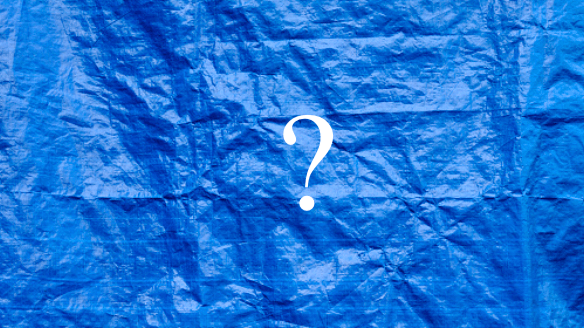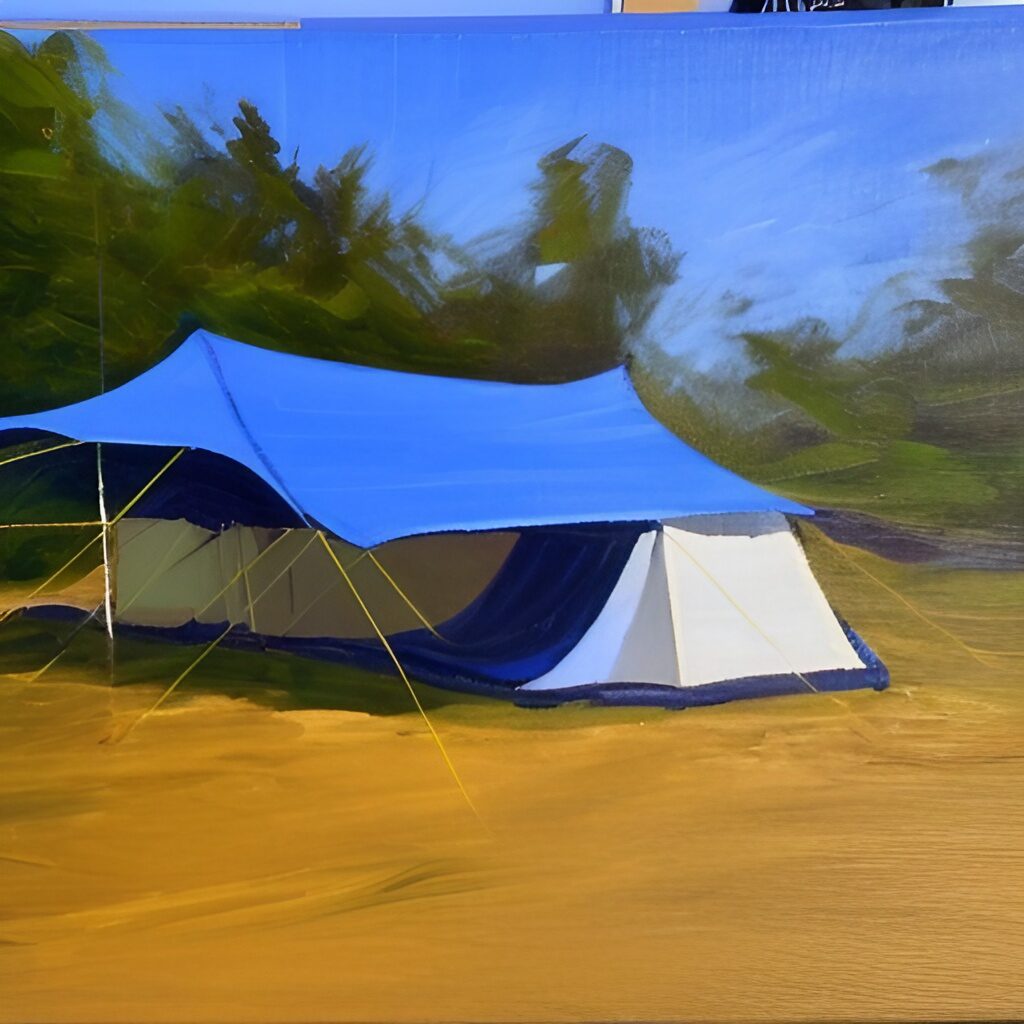
This is our analysis on “why are tarps blue?”
Whenever someone mentions the word tarp, it automatically conjures up an image of a blue, grommeted, available everywhere tarp. Blue tarps have long been the go-to tarp for many purposes, but why are they blue?
Blue tarps are a common sight and are often used as temporary shelters or coverings for items that need protection from the elements. Researching blue tarps does not give a clear-cut answer to such a question, and believe me, I’ve spent hours pouring over articles!
Tarps are blue as a means of identification based upon an informal color-coding system. The blue color typically indicates a tarp made of coated polyethylene that is typically waterproof, stretch resistant, UV resistant, and tear-resistant. Blue tarps can vary widely in weight and size, requiring a careful investigation to determine the best use for one.
A second reason why most tarps are blue is simply due to the availability and cost-effectiveness of the material. Blue polyethylene tarps are relatively inexpensive and widely available in a range of sizes and thicknesses. The color blue is also a practical choice because it is easy to see and stands out well in most outdoor environments, making it easier to spot and locate when used as a temporary shelter or cover. Additionally, blue tarps tend to reflect more light and heat than darker colors, which can help prevent overheating or damage to covered items.
Why Are tarps blue?
Blue tarps have long enjoyed popularity as the tarp of choice in part due to their affordability and availability.
But what are blue tarps meant to be used for? Their popularity does not rest solely on their price point and obtainability.
Blue tarps are typically intended for everyday, all-purpose use. These tarps are waterproof, low stretch, tear-resistant, and UV protected.
These features point to a clear purpose; blue tarps are meant for outdoor protective use.
This makes these tarps makes them ideal for construction projects and camping.
Campers are perhaps the most creative blue tarp consumers. Campers use blue tarps to create barriers under their tents, add additional waterproof covering over the top of their tents, and help block the wind!
Camping and construction are both activities that people engage in year-round, creating the ideal market for the blue tarp to continue to be a mainstay of affordability and accessibility.
What About Tarps of Other Colors?
While blue tarps are the most popular of all tarps, they aren’t the only variety. There are many other colors of tarps that come in various materials and thicknesses with different intended use.
Some other colors of tarps may also have very similar features to blue tarps, such as UV resistance, water resistance, and tear resistance.
The reason these tarps haven’t gained the same popularity as their blue counterparts may be a bit of a mystery; however, there are a few intuitive clues we can use.
The color-coding system with tarps is unofficial and more of a convention than a rule. The guidelines below are those that many manufacturers and consumers have agreed to based upon a mix of modern-day perceptions and basic science.
- Clear tarps are a great protective option that allows full sunlight. These are sometimes used to provide outdoor spaces with more protection from the elements without sacrificing a view or sun. Clear tarps are an excellent option for farmers or gardeners.
- Silver tarps are an excellent light reflective option, similar to a white tarp. These are great for when you need some extra protection from the heat of a full sun location.
- Black tarps absorb and retain heat, making them a good choice when you need warmth. Black tarps are often used as a means to heat a pool affordably and efficiently utilizing the sun.
- Camo tarps are an excellent option for when you want to blend in. Blending in can be useful when hunting, or when you’re camping and don’t want to disrupt wildlife around you with abrasive tent colors.
- Red tarps tend to be extra durable. They are similar to orange tarps in that the colors symbolize stop or proceed with caution. These can be used to alert others that you’re covering a hole in the ground or an area that needs extra care and attention when approaching.
Buying Guide: What to Look For in a Blue Tarp
When you’re shopping for a blue tarp, it’s essential to evaluate your camping needs before picking up any old blue tarp from the store.
Will you be using this for everyday camping purposes, such as lining the bottom of your tent to keep it from getting wet?
Do you intend to camp in more extreme conditions, such as heavy rain?
There are quite a few variables within the blue tarp market, making it even more important to know what you need and carefully read packages before buying.
- Size is an important factor to consider when buying a blue tarp. Blue tarps come in a wide range of sizes, so it’s essential to know how you’ll use it. Knowing your tent’s size is crucial to ensure you get a tarp that will provide full coverage for under or over your tent.
- Tarp thickness is another important variable to consider when purchasing a blue tarp. Tarp thickness is measured in mils, with higher numbers meaning thicker tarps. This number can vary dramatically with blue tarps.
If you’re using your tarp for regular camping and want it to last through a variety of climates and weather, it’s a good idea to choose a thicker tarp.
- Grommets can vary significantly in both amount and whether they are rustproof. If you have a specific purpose in mind, the total number of grommets per tarp is worth considering before purchasing.
Not all blue tarps offer rust-resistant grommets, so be sure to check the packaging to ensure your tarp can withstand many seasons of camping.
- Weatherproof blue tarps exist and are worth investigating if you plan on camping in a wide range of temperatures. Weatherproofed tarps tend to have different weaves or laminations to make them extra durable and resistant to cracking in extreme temperatures.
The tarp must specify it’s weatherproof or intended for temperature extremes, as not all blue tarps are meant to be used in a variety of climates.
Blue tarps are all-purpose, waterproof, UV resistant, and tear-resistant, making them ideal for various uses. Blue tarps are highly affordable and widely available, making them popular for campers, contractors, and home project enthusiasts.
Blue tarps are an excellent option to cover a diverse range of camping needs and are worth considering as an addition to your gear!

Why Are Tent Camping Tarps Blue? Conclusion
In summary, we learned there are a few different reasons why tarps are often blue:
- Cost: Blue polyethylene, which is the material most commonly used for tarps, is a relatively cheap and widely available material. Because of this, manufacturers can produce blue tarps at a lower cost than other colors.
- Visibility: Blue is a highly visible color, which can be important in some situations where a tarp is being used as a warning or safety device. For example, blue tarps are often used to mark off hazardous areas or to indicate that a construction site is off-limits.
- UV resistance: Blue tarps are often treated with special UV-resistant coatings to help them withstand the effects of the sun. This makes them a good choice for outdoor applications where the tarp will be exposed to sunlight for extended periods of time.
- Tradition: Finally, there may be a certain amount of tradition or habit behind the use of blue tarps. Because they have been used for so long and are so widely recognized, manufacturers may simply continue to produce blue tarps because it’s what people expect to see.
Blue Tent Camping Tarps- Frequently Asked Questions
Here are some frequently asked questions about blue camping tarps:
- What is the size of a typical blue camping tarp? Blue camping tarps are available in a variety of sizes, ranging from small sizes of around 5 feet by 7 feet to large sizes of around 20 feet by 30 feet. The size you choose will depend on your camping needs.
- How can I use a blue camping tarp? Blue camping tarps can be used in a variety of ways, such as providing shelter from the rain, creating a shaded area, covering your camping gear, and more. They are a versatile camping accessory that can be used in many different situations.
- Are blue camping tarps waterproof? Yes, most blue camping tarps are designed to be waterproof. They are made from materials that are resistant to water, which makes them ideal for use in wet conditions.
- Can I use a blue camping tarp as a ground cover? Yes, blue camping tarps can be used as a ground cover to protect your tent and gear from moisture and dirt. They can also provide an extra layer of insulation from the cold ground.
- How do I secure a blue camping tarp? Blue camping tarps typically come with grommets or loops along the edges, which you can use to secure them with stakes or ropes. Some tarps may also come with built-in straps or buckles that make it easier to secure them.
- How do I clean my blue camping tarp? To clean a blue camping tarp, simply wipe it down with a damp cloth and mild soap. You can also rinse it with a hose and allow it to air dry. Avoid using harsh chemicals or bleach, as this can damage the tarp.
- When should you replace a blue camping tarp? The lifespan of a blue camping tarp depends on several factors, including the quality of the tarp and how often it is used. However, a tarp that has holes, tears, or other damage that cannot be repaired should be replaced. Additionally, if the tarp is no longer waterproof or is showing signs of significant wear and tear, it may be time to replace it. It’s a good idea to regularly inspect your camping tarp before each use to ensure that it is in good condition.














